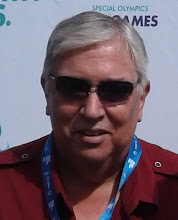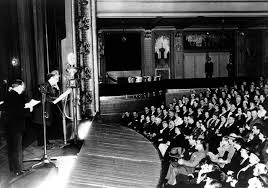"Public Enemies Even the G-Men Cannot Reach": The Way It Was, 31 January
1936---Three years and a day to the day his great uncle premieres, nocturnal crimefighter The Green Hornet---starring Al Hodge as the playboy heir turned crusading newspaper publisher Britt Reid, who disguises himself as the title character---premieres on the same Detroit station, WXYZ.
Both are the creation of George W. Trendle and his writer Fran Striker, with Reid revealed in due course to be the great-nephew of John (The Lone Ranger) Reid. Unlike the Silver Bullet Rider, however, the younger Reid turns a twist on the Lone Ranger's style: the Green Hornet infiltrates underworld operations or challenges them for rackets as if an underworlder himself . . . the better to break up those rackets, even if it means allowing himself to be seen as a wanted major criminal by authorities, an image he uses as a crimefighting weapon in its own right.
Reid at first tells no one of his double life beyond his valet, Kato, who is portrayed first as a Japanese-American, then as a Filipino-American (following Pearl Harbour), and finally as a Korean-American. Or, was he?
Kato, Britt Reid's faithful valet, was an Oriental, a distinction of some consequence after the Japanese drew the USA into World War II by launching a surprise attack on Pearl Harbor on 7 December 1941. From this era arose the legend that the character of Kato was originally identified as being Japanese, but after Pearl Harbor his nationality was abruptly changed to Filipino.Was there a change? Some people insist there was, others claim that Kato was an Oriental of unspecified nationality prior to the attack on Pearl Harbor and the "Filipino" aspect of his character was emphasized afterwards (understandably leaving some listeners with the impression that a change had occurred), and yet another group asserts that Kato had been explicitly Filipino all along. In this case we defer to the expertise of John Dunning, who notes in his comprehensive encyclopedia of old-time radio that although Kato was voiced by an actor of Japanese descent (Tokutaro Hayashi, later "renamed Raymond Toyo by director James Jewell for professional reasons"), he was "described as a Filipino of Japanese descent at least two years earlier" than the events of 7 December 1941. The "Japanese descent" part of his character may have been downplayed thereafter, but he had indeed been identified as a Filipino well before 1941.---Snopes.com
In due course, however, the radio Green Hornet will be exposed inadvertently by a woman and, from there, share his dual identity with the police commissioner.
The Green Hornet will become a network radio offering on Mutual, NBC Blue, and ABC before expiring in the mid-1950s. A decade later, it will air for a single season on television, with Van Williams as Britt Reid and Bruce Lee as Kato (who is now Chinese-American); Reid’s dual identity this time is known to his secretary, Lenore Case, and to district attorney Frank Scanlan.
The radio Hornet carries no weapon other than a non-lethal gas gun and his jiu jitsu-trained valet, not to mention a high-powered car, the Black Beauty, that can get him from point A to point B faster than any police cruiser. (The television Hornet, of course, will add a retractable electronic laser, or "sting," through which he can cut through thick layered steel and iron, and a Black Beauty affixed with short-range rockets and gas shells and a deployable electronic aerial scanner.)
Within its first few old-time radio seasons, however, FBI director J. Edgar Hoover will take a troublesome interest in The Green Hornet. Hoover will object to the show’s introduction ("He hunts the biggest of all game: public enemies that even the G-men cannot reach") because it offends him that the line implies there are criminals beyond the FBI's competence to stop. He'll prevail upon the show producers to substitute a less offencive but somewhat more cartoonish introduction. ("He hunts the biggest of all game: public enemies who try to destroy Our America.")
With Hodge, the original cast of The Green Hornet includes Raymond Hayashi as Kato, Lee Allman as Lenore (Casey) Case, Jim Irwin as Mike Axford (a Daily Sentinel reporter with a robust Irish brogue and a past as a police officer whose service is implied to have ended under less than honourable circumstances), and Jack Petruzzi as reporter Edward Lowry.
Rollon Parker plays the unidentified newsboy who ends virtually every episode with a street corner holler selling Daily Sentinal "extrys" following the Green Hornet's latest crimebusting---always ending with the line, "Green Hornet still at large!" Within a decade, however, he'll serve double duty, becoming the second Kato, before handing that role off to Mickey Tolan.
Hodge will play the Green Hornet through 1943; Donovan Faust and Bob Hall will play the role in 1943; and, Hall continues until 1946. His successor and the final radio Hornet will be Jack McCarthy, later the host (known as Captain Jack) of local children’s programming in New York City . . . and the annual anchor for WPIX-TV coverage of New York’s St. Patrick’s Day parade.
Allman and Petruzzi are the only actors to keep their roles for the life of the radio series. The show's announcers will include Fielden Farrington, Robert Hite, Harold Neal, Charles Woods, and future 60 Minutes founding co-anchor Mike Wallace.
CHANNEL SURFING . . .
1937: NIGHTMARES OF FRED ALLEN; OR, JACK TO PLAY "THE BEE"---Addled with a cold, it's almost time to put up or shut up for Jack (Benny), who's been cleaned at the racetrack when not rehearsing "The Bee" ever since Allen's crack following young Stuart Canin's performance, and he ponders whether bribery was involved among other subterfuges, on tonight's edition of The Jell-O Program Starring Jack Benny. (NBC.)
Cast: Mary Livingstone, Kenny Baker, Phil Harris, Don Wilson. Music: Phil Harris Orchestra. Writers: George Balzer, Al Boasberg, Milt Josefsberg, John Tackaberry.
1937: EDDIE'S BIRTHDAY---Ol' Banjo Eyes (Eddie Cantor) gets a birthday bash that includes a few comic greetings, a dinner (he thinks) from orchestra leader Jacques Benard, a backhanded salute from his sponsor, and other offbeat treats, on tonight's edition of Texaco Town. (CBS.)
Additional cast: Parkyakarkus (Harry Einstein), Deanna Durbin, Bobby Breen, Pinky Tomlin. Announcer: Jimmy Wallingford. Music: Jacques Benard. Writers: Possibly Philip Rapp, Carrol Carroll, David Freedman, Bob Colwell.
1940: EMPHASIS ON THE "BOOM"---If you can forgive him for trying to make a jazz swinger out of "Ta-Ra-Ra-Boom-De-Ay" (in a just world it would get you tried by jury for attempted murder---of jazz), you can have a pleasant time listening otherwise to Gene Krupa and his Orchestra playing the Meadowbrook (on the Newark-Pompton Turnpike in New Jersey, the same pike that once provided Charlie Barnet with a secondary theme for his band), on tonight's edition of Krupa's weekly radio remote. (NBC.)
1943: THE CONFESSION---An underworld gambler who killed a rival in self defence romances a young woman whose father is a successful defence attorney priding himself on rejecting guilty clients . . . but the gambler's scorned former lovers include her stepmother, who finds one way to get even with him---so it seems---on tonight's edition of The Whistler. (CBS.)
Additional cast: Unknown. The Whistler: Probably Joseph Kearns. Music: Wilbur Hatch. Writer: J. Donald Wilson.
PREMIERING TODAY . . .
1872---Zane Grey (writer: The Rudy Vallee Show), Zanesville, Ohio
1892---Eddie Cantor (as Israel Iskowitz; a.k.a. Adrian Cantrowitz; comedian/singer/actor: The Chase & Sanborn Hour; Texaco Town; Time to Smile; The Big Show), New York City.
1902---Tallulah Bankhead ("the glamorous, unpredictable" host: The Big Show), Huntsville, Alabama.
1905---John O'Hara (writer: Information Please), Pottsville, Pennsylvania.
1906---Edith Adams (actress: Those Happy Gilmans), West Union, Iowa.
1908---Connie Desmond (sportscaster: play-by-play partner with Red Barber for the 1940s-1950s Brooklyn Dodgers), Ohio.
1909---Walter Coy (actor: Lone Wolf), Great Falls, Montana.
1913---Maurice Manson (actor: One Man's Family), unknown.
1915---Garry Moore (as Thomas Garrison Morfit; host: Take It or Leave It; Beat the Band; comedian: The Durante-Moore Show; The Garry Moore Show), Baltimore.
1921---John Agar (actor: The Big Show), Chicago; Carol Channing (singer-actress: Arthur Godfrey Time;, Stagestruck), Seattle; Mario Lanza (operatic tenor: The Mario Lanza Show), Philadelphia.
1923---Joanne Dru (as Joanne Letitia LaCock; actress: Lux Radio Theater), Logan, West Virginia.
1929---Jean Simmons (actress: Lux Radio Theater), London.
1892---Eddie Cantor (as Israel Iskowitz; a.k.a. Adrian Cantrowitz; comedian/singer/actor: The Chase & Sanborn Hour; Texaco Town; Time to Smile; The Big Show), New York City.
1902---Tallulah Bankhead ("the glamorous, unpredictable" host: The Big Show), Huntsville, Alabama.
1905---John O'Hara (writer: Information Please), Pottsville, Pennsylvania.
1906---Edith Adams (actress: Those Happy Gilmans), West Union, Iowa.
1908---Connie Desmond (sportscaster: play-by-play partner with Red Barber for the 1940s-1950s Brooklyn Dodgers), Ohio.
1909---Walter Coy (actor: Lone Wolf), Great Falls, Montana.
1913---Maurice Manson (actor: One Man's Family), unknown.
1915---Garry Moore (as Thomas Garrison Morfit; host: Take It or Leave It; Beat the Band; comedian: The Durante-Moore Show; The Garry Moore Show), Baltimore.
1921---John Agar (actor: The Big Show), Chicago; Carol Channing (singer-actress: Arthur Godfrey Time;, Stagestruck), Seattle; Mario Lanza (operatic tenor: The Mario Lanza Show), Philadelphia.
1923---Joanne Dru (as Joanne Letitia LaCock; actress: Lux Radio Theater), Logan, West Virginia.
1929---Jean Simmons (actress: Lux Radio Theater), London.












0 Comments:
Post a Comment
Subscribe to Post Comments [Atom]
<< Home